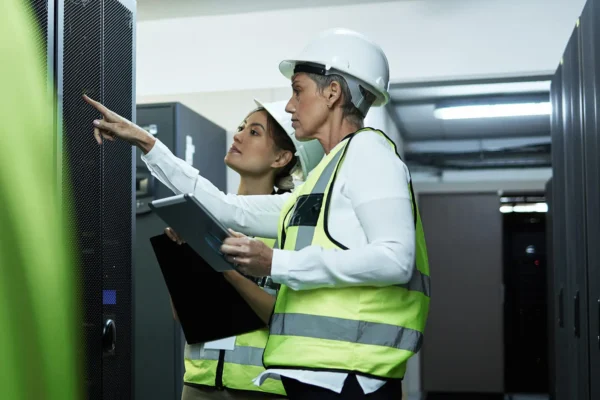Data Centre Health and Safety:
10 Key Risks and How to Mitigate Them
TL;DR: Data Centre Health and Safety is essential to keep operations smooth, protect valuable data, and prevent accidents. Data centres face unique risks like electrical hazards, fire threats, and temperature control issues that can disrupt services if not managed effectively. This guide covers the 10 key health and safety risks in data centres and offers practical ways to mitigate them, ensuring the safety of your infrastructure and continuity for your business.

With data centres serving as the backbone of our digital age, data centre health and safety is a serious priority. It’s crucial to maintain rigorous standards within these facilities.
At Pro Safety Management, we bring our telecoms health and safety expertise, built from over 50 years of working across complex infrastructure projects, to help keep your data centres safe, efficient, and compliant.
Why Is Data Centre Health and Safety So Important?
As we’re sure you already know, data centres house critical IT infrastructure, and their uninterrupted operation is essential for businesses worldwide. However, these sites come with extremely unique hazards – from electrical risks to cooling systems and confined spaces. Effective health and safety management in data centres not only prevents accidents but also protects the vital data stored within, securing business continuity.
You probably don’t want to, but imagine a scenario where the cooling system fails due to a minor oversight in maintenance. Within minutes, server temperatures could skyrocket, causing equipment to overheat and potentially shut down. The ripple effect of this single failure could be severe, affecting everything from internal operations to customer-facing services. Simply put, these are hazards you want to avoid. So, here are the 10 key risks in data centres and how to mitigate them effectively.

1. Electrical Hazards
Electrical risks are prevalent in data centres due to high-voltage equipment and complex power distribution systems. Even minor issues, such as faulty wiring or equipment malfunction, can lead to severe injuries or major disruptions. To minimise risks, it’s crucial to adhere to best practices and follow regulatory guidelines.
According to the UK Health and Safety Executive (HSE) guidelines on electrical safety, regular inspections and routine maintenance of electrical systems are essential in identifying and addressing potential hazards early. To minimise risks:
- Conduct regular inspections and maintenance of electrical systems.
- Ensure all employees working near electrical equipment are adequately trained and provided with protective equipment.
Additionally, all employees working near electrical equipment should receive comprehensive training and be provided with protective equipment to ensure safe handling. For a more comprehensive approach, we offer specialised E-Learning courses and on-site training tailored to data centre environments.
2. Fire Hazards
The vast amount of electronic equipment in data centres poses a significant fire risk, especially in densely packed areas where overloaded circuits or faulty wiring are common. To reduce these risks, key preventative steps include:
- Implementing a robust fire detection and suppression system.
- Conducting regular fire risk assessments to identify and address potential hazards early.
According to the Fire Safety (England) Regulations 2022, conducting regular fire risk assessments is critical in identifying and addressing potential hazards before they become serious threats. These assessments help ensure compliance and protect both staff and infrastructure.Be sure to check out our guide on the importance of a fire risk assessment and how to conduct one. If you need any additional help, don’t hesitate to get in touch!
3. Air Quality and Ventilation Issues
Proper ventilation is crucial in data centres to manage heat and ensure good air quality. Poor air quality can lead to respiratory issues for workers. To ensure air quality:
- Schedule regular inspections of air filtration systems.
- Maintain adequate ventilation to keep air quality within safe levels.
4. Temperature Control Hazards
Data centres generate significant heat due to extensive equipment, requiring precise temperature control to prevent overheating and costly shutdowns. Overheating can lead to equipment failure and health risks for staff. So, maintaining the right temperature is essential for both equipment and personnel. To mitigate temperature-related hazards:
- Ensure reliable HVAC systems are in place.
- Set up alarms and monitoring systems to alert staff of temperature fluctuations.
5. Ergonomic Risks
Data centre tasks, such as equipment installation and cable management, often involve repetitive movements and awkward postures that can lead to ergonomic strain and injury over time.
To minimise these risks, here’s what you can do:
- Conducting regular ergonomic assessments.
- Training employees on safe lifting techniques and using ergonomic tools.
According to the Chartered Institute of Ergonomics and Human Factors (CIEHF), implementing the measures mentioned above places significantly less strain on employees, improving both productivity and overall workplace health.
6. Falls and Trips
Data centres can become hazardous with numerous cables, elevated floors, and narrow aisles. A simple trip could lead to injuries or equipment damage. As we all know, worker safety is paramount, here are the preventive actions:
- Keeping walkways clear and properly marked.
- Installing anti-slip mats and appropriate lighting.
Effective Site Safety Management is crucial in preventing trip hazards and ensuring smooth, safe movement throughout a data centre. By proactively managing site conditions, you can identify and address potential risks early, reducing the likelihood of accidents and protecting both personnel and equipment.
7. Confined Spaces
Data centres often feature confined areas such as cooling ducts and cable trays, which can be hazardous if not properly managed. Working in these spaces requires specific precautions, here’s what the Health and Safety Executive’s guide on working in confined spaces recommends:
- Confined space training for employees.
- Ensuring proper ventilation and monitoring oxygen levels.
For a detailed approach to confined spaces, refer to our blog on Telecoms Confined Spaces: A Guide To Working Safely.
8. Emergency Procedures
Given the high-value equipment and sensitive nature of data centres, robust emergency procedures are essential. This includes training staff on:
- Evacuation routes and protocols.
- Emergency shutdown procedures for equipment.
Whether you’re looking for safety training or an in-depth explanation of safety procedures, our expert team of Health & Safety Consultants can work with you to develop and refine emergency protocols tailored to your data centre’s needs.
9. Security Threats
Physical security is a growing concern as data centres become targets for theft and sabotage.
Key steps to mitigate security risks include:
- Implementing multi-level security checks.
- Training staff to recognise suspicious behaviour and follow security protocols.
10. Equipment and Tool Safety
The specialised tools used in data centres, such as testing devices and power tools, present risks if not properly managed. It’s also crucial that site members wear personal protective gear, when necessary! To reduce accidents:
- Maintain a strict inventory and regular inspections of all tools.
- Ensure that only trained personnel handle specific equipment.
Interested In a Safer, More Efficient Data Centre Health and Safety Process?
Managing health and safety in data centres is a complex, ongoing task. However, by addressing these 10 key risks and following safety guidelines, you can create a safer environment for both your personnel and the equipment they rely on.
With over 50 years of telecoms expertise, here at Pro Safety Management we are equipped to conduct comprehensive health and safety audits for your data centres, ensuring your facilities operate safely, efficiently, and in full compliance with industry standards.
For more information on how we can support your health and safety needs, visit our Telecoms Health & Safety Services page, or contact us directly below to discuss a tailored audit solution for your data centre.
Get in Touch

Do you want to ensure Health & Safety Compliance?
With over 50 years of telecoms expertise, we are equipped to conduct comprehensive health and safety audits for your data centres, ensuring your facilities operate safely, efficiently, and in full compliance with industry standards.






